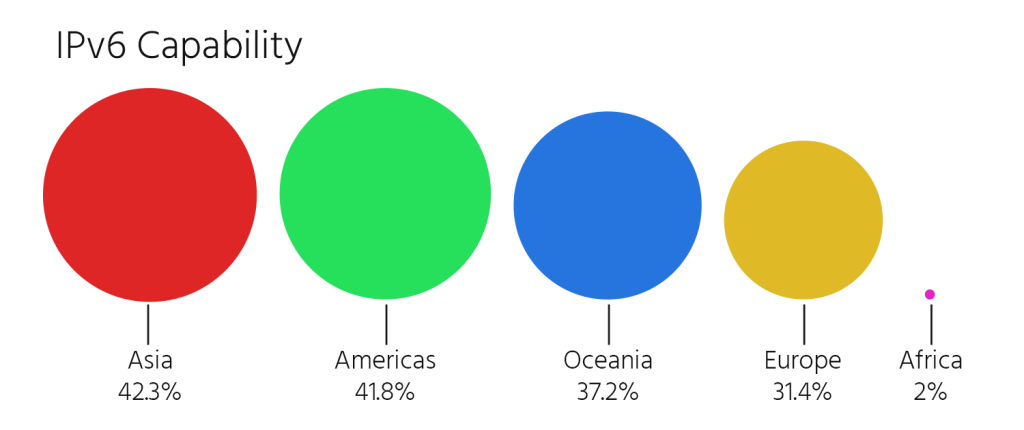On Pulse, we collate various measurements to illustrate the deployment of critical Internet technologies at a country level and across global networks. In this post, we’ll review notable changes in IPv6 deployment in each region over the past 12 months and what we may expect in 2024.
IPv6 Deployment Increased Globally The Most It Has Since 2018
In 2023, the rate of IPv6 deployment increased the most it has since 2018, growing from 34% to 39% globally — IPv6 deployment has risen an average of 3.5% each year since December 2017.
Per APNIC Labs, the most significant gains were measured in the Asia Pacific region, where IPv6 deployment across Asia increased from 37.2% at the end of 2022 to 42.3% at the end of 2023, and across the same time, Oceania increased from 31.9% to 37.2%.
In the process, Asia overtook the Americas for the highest percentage of IPv6 deployment, while Oceania extended its gap over Europe, which finished the year with 31.4%.

Figure 1 — IPv6 capability per region at the end of 2023. Source: APNIC Labs.
Asia Pacific
At the end of 2023, ten Asia Pacific countries ranked in the top 20 countries globally for IPv6 deployment, the most of any region, and 31 of its 76 countries and territories ended the year with greater than 10% IPv6 deployment.
Mongolia saw the most significant jump of all countries and territories in the region, increasing from 4.5% to 29.8%, thanks to its incumbent telco, Unitel, becoming the first major network to deploy IPv6 in the country.
Read: Unitel gets the IPv6 ball rolling in Mongolia.
Other notable increases occurred in Nepal (+15.2%), Bangladesh (+11.3%), Taiwan (10.5%), Bhutan (10.3%), Viet Nam (+9.2%), Pakistan and Malaysia (+8.6%), and French Polynesia, Israel and Japan (+8.4%).
While India’s (+4%) and China’s (+4.8%) increases may seem modest compared to the above, and those they’ve made in previous years, the fact that they are assigned the most networks of all countries in the region means any increases are significant. In the case of India, it also extended its lead as the number one ranked country in the world when it comes to using IPv6.
In 2024, we will closely monitor whether other networks in Bahrain, Bangladesh, Mongolia, Papua New Guinea, and Qatar will follow the lead of the large networks that were first to start deploying IPv6 in 2023 in their countries. We will equally be interested in Indonesia, which, as the country with the third most assigned networks in the region, has a modest IPv6 deployment percentage of 13.5%.
Europe
Europe crossed 30% IPv6 deployment in 2023, finishing the year at 31.4%, up from 28% at the end of 2022. It has more than doubled its IPv6 deployment in the past five years.
While Belgium has held the number one rank in Europe since 2015, France overtook it, even if for only a few weeks, in 2023, thanks mainly to its second-largest operator, Societe Francaise Du Radiotelephone (AS15557), continuing its substantial gains in 2022 to join France’s three other largest operators at or above 60% IPv6 deployment.
It is conceivable that by the end of 2024, France’s top four operators will have deployed IPv6 across at least 80% of their networks.
Norway had the most significant jump in IPv6 deployment of all countries in Europe, increasing from 25.9% at the end of 2022 to 40.8% at the end of 2023, thanks to its largest operator, ALTIBOX (AS29695), more than doubling its IPv6 deployment to end the year at 60%. See data for Norway.
Its neighbor, Sweden, also saw its IPv6 deployment nearly double across 2023, jumping from 11.7 to 22.5%, thanks to its largest operator, Telia (AS3301), ramping up its IPv6 transition in the final quarter of the year (9.7 to 26%). See data for Sweden.
The most significant movement came from the countries ranked 5th, 6th, and 8th for the most number of assigned networks in the region: Spain, Italy, and Ukraine.
As reported on Pulse earlier in the year, Spain’s largest operator, Telefonica (AS3352), started its IPv6 transition, growing from 0 to 17.5%, resulting in the country’s IPv6 deployment jumping from 4.3% to 9.4%. See data for Spain.
Italy also doubled its IPv6 deployment from 6.8 to 13.6% across the year thanks to two of its largest three providers, Vodafone Italia (AS30722) and WindTre (AS1267), beginning their IPv6 transitions. See data for Italy.
The above pales compared to Ukraine’s gains in 2023, which increased its overall IPv6 deployment from 0 to 13% (it dropped to 9.6% by the end of the year) amidst its ongoing war with Russia. Again, this increase was propelled by a country’s largest operator, Kyivstar (AS15895), which started its transition to IPv6 in September 2022. See data for Ukraine.
It’s worth noting that while Kyivstar has deployed IPv6 across nearly half of its network, this has only increased Ukraine’s overall IPv6 deployment percentage by 13%. This is evidence of Ukraine’s excellent ISP diversity (as per the Pulse Country Report for Ukraine), which is influential in terms of its overall Internet Resilience Index, which we’ve been tracking since the start of the war.
Read: Case Study: Ukraine – A Role Model for Internet Resilience
Looking towards 2024, we expect to see the above countries continue to increase their rates of IPv6 deployment and influence smaller networks in their countries to follow their lead.
We are also interested in seeing how the recent announcement by the Czech government that all government networks will have to be running IPv6-only by 2032 will affect its IPv6 deployment figures (it ended the year ranked 20th in Europe, with 21.6% of its overall network capacity IPv6 capable) and whether governments in other countries in Europe and around the world will follow its lead. Governments play an essential role in the uptake of critical technologies, both as policymakers and as Internet customers — governments are among the most significant IT customers in most countries.
Americas
Having led the way in IPv6 deployment for a decade, IPv6 deployment in the Americas plateaued significantly in 2023, only increasing by 1.7%.
Of the top 10 largest countries by population in the region, the USA (54%), Mexico (48%), Colombia (54%), Canada (36%), and Peru (28%) had little to no gain in IPv6 deployment across the 12 months. In contrast, Argentina (+5.5%), Brazil (+5.4%), Chile (3.2%), and Ecuador (3%) saw continued progression.
While Venezuela ranks among the lowest for IPv6 deployment of all 55 countries in the Americas (2.5%), one network (AS264628) increased its individual IPv6 deployment percentage from 18% to 39% in 2023, contributing 1.5% to the national percentage.
Smaller countries have historically not featured in the list of countries with the most significant percentage of IPv6 deployment as there has yet to be a strong business case for them to deploy it, given most have enough IPv4 addresses to accommodate their smaller user base. However, several smaller nations in the Americas jumped considerably in the rankings in 2023, thanks to one of their two largest telcos starting to deploy IPv6.
The most significant of these jumps was Domenica, which, thanks to its largest telco, SATTEL (AS40945), deploying IPv6 on its network, rose from less than 1% to 45.8%. It now ranks 8th in the Americas and 31st globally.
Other impressive jumps included Turks and Caicos Islands (+27%), Anguilla (+24%), Dominican Republic (+10%), Paraguay (+9%), Guatemala (8.7%), and Costa Rica (+8.5%). It will be interesting to see if other operators in these nations will follow the lead of the networks that have deployed IPv6 and whether operators in other smaller nations show little to no IPv6 deployment.
Africa
Africa ended the year with, by far, the lowest IPv6 deployment percentage (2%). However, there were several notable increases in Mayotte and Reunion thanks to deployments by France Telecom-Orange in both countries and the first signs of IPv6 deployment in Senegal and Tunisia, thanks to the second (Cloudflare) and largest networks (Tunisie Telecom), deploying IPv6 in their respective countries.
In the latter’s case, we expect to see IPv6 deployment increase further in 2024, given that Tunisie Telecom is the incumbent telecom operator in Tunisia and only announced its plan to transition to IPv6 in September. Another country we will watch in 2024 is Botswana, where the regulator announced in November that it is setting a target for the country to fully convert by 2030; less than 1% of the country’s traffic is via IPv6.
In the case of Tunisia, we expect to see IPv6 deployment grow further in 2024, given that the incumbent telecom operator in Tunisia only announced its plan to transition to IPv6 in September.


